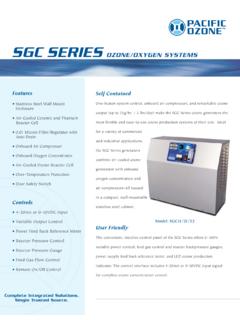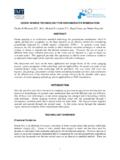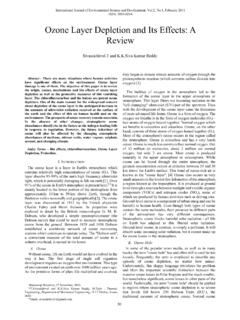Transcription of Ozone: Health hazards and control methods …
1 Health and Safety Executive ozone : Health hazards and control measures Guidance Note EH38. EH38 (Third edition) Published 2014. This guidance is primarily aimed at employers and managers of people exposed to ozone in the course of their work. Other groups, such as employees and Health and safety professionals, will also find the guidance useful. It draws attention to the potential ill Health which exposure to ozone can cause and indicates potential sources of ozone at work as well as offering advice on the precautions you may need to take to prevent or control exposure. Page 1 of 10. Health and Safety Executive Contents Introduction 3. Occurrence and properties 3. Effects on Health 3. ozone in the workplace 4. Complying with the COSHH Regulations 5. Prevention and control of exposure 6. Maintenance, examination and testing of control measures 7. Monitoring exposure 7.
2 Reporting symptoms 8. First aid 8. Information, instruction and training 9. Emergency procedures 9. Consulting 9. References and further reading 9. Further information 10. ozone : Health hazards and control measures Page 2 of 10. Health and Safety Executive Introduction 1 This guidance note is for employers and managers of people exposed to ozone in the course of their work. Other groups, such as employees and Health and safety professionals, will also find this guidance useful. 2 It draws attention to the potential ill Health which exposure to ozone could cause and indicates potential sources of exposure at work. It gives advice on the precautions which you may need to take to prevent or control exposure as required by the control of Substances Hazardous to Health Regulations 2002 (COSHH). It does not discuss environmental exposure to ozone or atmospheric ozone -depleting substances.
3 3 This guidance should be read in conjunction with the COSHH Approved Code of Practice (ACOP).1. Occurrence and properties 4 ozone (O3) is a form of oxygen. It is a colourless gas with a distinctive odour and is a normal constituent of the earth's atmosphere. It is about times heavier than air (density g/I). 5 ozone is produced naturally from oxygen whenever sufficient ultraviolet (UV). radiation or electrical discharges occur, for example at high altitudes or by the action of lightning. Such natural occurrences are unlikely to produce hazardous concentrations at ground level. The majority of ozone found near ground level is formed by photochemical reactions involving oxides of nitrogen and hydrocarbons. 6 ozone is an unstable substance, but its rate of decomposition varies widely depending on temperature and humidity. A given ozone output which yields a faint trace of ozone in a workroom atmosphere on a humid day may create an undesirable concentration on a dry day.
4 These factors are important when considering occupational exposure to ozone . 7 ozone is a powerful oxidising agent and can react explosively with oil and grease. Low concentrations of ozone have a significant effect upon textiles, fabrics, organic dyes, metals, plastics and paints and cause the characteristic cracking of stressed rubber, commonly called weathering'. A few substances, such as glass and some grades of stainless steel are, however, resistant to the oxidising effects of ozone . 8 ozone is not classified under the Regulation on Classification, Labelling and Packaging of Substances and Mixtures (known as the CLP Regulation). ozone cannot be stored or transported in vessels because it decomposes spontaneously in the presence of oxidisable impurities, humidity and solid surfaces. It is always generated in situ, for immediate use, and is extremely unlikely to be supplied as a commodity.
5 Labelling phrases are therefore inappropriate. Effects on Health 9 Since ozone is a highly reactive substance, any adverse Health effects will be found essentially at the sites of initial contact: the respiratory tract (nose, throat and airways), the lungs, and at higher concentrations, the eyes. The principal Health effects are produced by irritation of and damage to the small airways of the lung. However, people have considerable variation in sensitivity. ozone : Health hazards and control measures Page 3 of 10. Health and Safety Executive 10 Uncontrolled exposure to relatively high levels of ozone could lead to more severe Health effects, including lung damage. At the levels of exposure likely to be normally found in the workplace the main concern is irritation of the (upper) airways, characterised by coughing and a feeling of tightness in the chest. 11 This guidance on establishing effective risk management measures for controlling exposure to ozone focuses on the control of exposure to levels at which any Health effects, if they did occur, would not be significant (see paragraph 28).
6 ozone in the workplace 12 ozone is produced industrially by bombarding oxygen with UV radiation or by passing air through a high-voltage ac electrical discharge. It is used for a wide variety of industrial purposes including: to improve air quality in offices and as an odour suppresser in hotel bedrooms, commercial kitchens and cafeterias, food and fish processing plants, rubber compounding plants, chemical plants, sewage treatment works and cold stores;. as a disinfectant in the production of drinking water;. to overcome taste, odour and peaty colour problems in drinking water;. as part of the water treatment process in the removal of pesticides;. as a disinfectant in swimming pools and hot and cold water systems;. for pre-treatment in coating applications including inks, wood finishing, metal decorating and general industrial finishing;. for pre-treatment of plastic surfaces immediately before printing.
7 As a bleaching agent in both the textile and foodstuff industries;. as a reaction initiator in the chemical industry. ozone is also produced as an incidental by-product of many industrial activities, some of which are described below. Ultraviolet radiation 13 During electric arc welding (specifically TIG and MIG/MAG techniques), metals are arc welded in the presence of a shielding gas. The UV radiation from the arc produces significant quantities of ozone , the risks of exposure being particularly significant when welding aluminium and stainless steel. 14 ozone is also produced near many types of lamp which emit UV radiation. Such lamps are used in a variety of processes, for example: ink curing: some printing inks, varnishes and lacquers are composed of chemicals formulated to polymerise rapidly into hard resins upon exposure to UV radiation;. projection lamps: high-pressure xenon lamps used in cinema projectors emit some UV radiation and also produce ozone .
8 High-voltage electrical equipment 15 ozone is also produced around high-voltage equipment and by electrical discharges in specific processes. Some examples are given below: electrostatic precipitators: these are used to remove dust and some airborne contaminants from the air where ozone is produced incidentally;. static eliminators: these are used in industry to remove static electricity from recently moulded plastic articles. The main factor which determines the amount of ozone generated is the voltage across the collector plates; the higher the voltage the more ozone is produced;. X-ray machines. ozone : Health hazards and control measures Page 4 of 10. Health and Safety Executive Complying with the COSHH Regulations The workplace exposure limit (WEL). 16 The current WEL2 for ozone is ppm in air averaged over a 15-minute reference period. If exposure to ozone cannot be prevented then the principles of good control practice need to be applied (see Schedule 2A of COSHH regulation ).
9 To ensure that the workplace exposure limit is not exceeded. Assessment 17 Under COSHH regulation 6, employers must not carry out any work which is liable to expose any employees to any substance hazardous to Health . This is unless they have made suitable and sufficient assessment of the risks created by that work to the Health of those employees and of the steps that need to be taken to meet the requirements of COSHH. You will need to carry out a suitable and sufficient' risk assessment wherever exposure to ozone is likely to occur. 18 HSE guidance A step by step guide to COSHH assessment3 describes in general terms how to make an assessment. Guidance is also given in the COSHH. ACOP. An action plan/checklist for assessment would involve: where is ozone likely to be generated? is exposure likely? who is likely to be exposed? can the exposure be prevented? if the exposure cannot be prevented, estimate the potential level of exposures (in some cases this may involve personal exposure monitoring).
10 If you can demonstrate that your estimate of exposure is unlikely to exceed the WEL, you do not need to take any further action;. if exposures exceed or are likely to exceed the WEL, decide what control measures are needed and take appropriate action. The assessment must be reviewed regularly. Low-risk work activities 19 With some work activities, there may be exposure to small amounts of ozone that is without any significant risk to Health . These low-risk work activities are mainly encountered in office-type environments. They include working with most types of photocopiers, printers, projectors, X-ray machines (all types: medical, dental, industrial), and some types of room deodoriser. 20 The risks to Health are slight and in general any symptoms shown will be irritation of the respiratory tract. However, employers should be aware that it is possible in certain cases to build up levels of ozone in excess of the WEL in inadequately ventilated rooms (see paragraph 16).










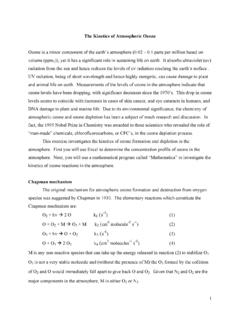

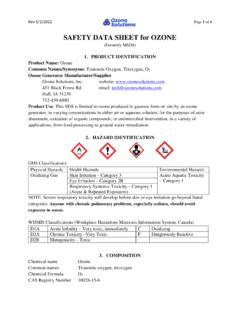
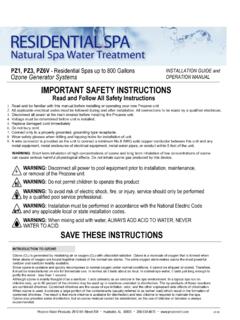
![SAFETY DATA SHEET [formerly MSDS] 1 PRODUCT …](/cache/preview/b/8/1/9/4/d/b/f/thumb-b8194dbf3233d95ad71de2848134ba9c.jpg)
